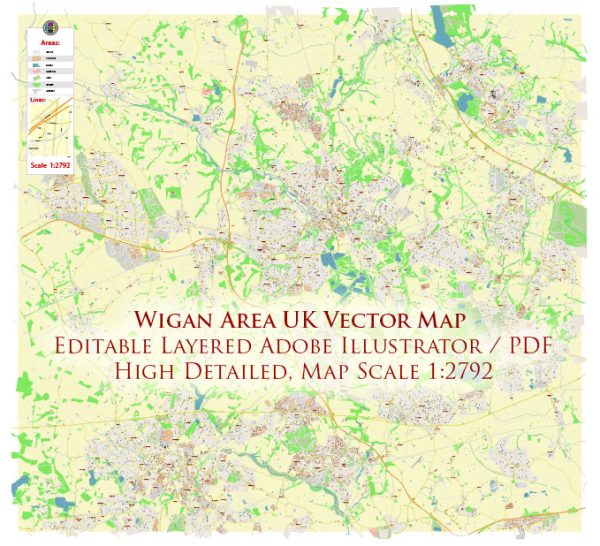Wigan is a town in Greater Manchester, England, with a rich history dating back to Roman times. While it might not be as well-known as some other historic cities, Wigan has several interesting historic places, buildings, streets, and squares that showcase its cultural and architectural heritage.
Vectormap.Net provide you with the most accurate and up-to-date vector maps in Adobe Illustrator, PDF and other formats, designed for editing and printing. Please read the vector map descriptions carefully.
Here are some notable places in the Wigan area:
- Wigan Parish Church (All Saints’ Parish Church):
- Located in the town center, this medieval church dates back to the 14th century and has undergone various renovations over the years. It features a striking tower and is an important religious and architectural landmark.
- Wigan Pier:
- Wigan Pier is a historic site along the Leeds and Liverpool Canal. Originally, Wigan Pier referred to a coal-loading staithe where coal was transported from the mines to the canal. The area became famous thanks to writer George Orwell, who used the term in his book “The Road to Wigan Pier” to describe the harsh living conditions of the working class.
- Trencherfield Mill:
- This Victorian cotton mill is a symbol of Wigan’s industrial heritage. Trencherfield Mill is a Grade II listed building and is notable for its large steam engine, which is one of the largest and finest working examples of its type.
- Wigan Town Hall:
- The town hall is an impressive Victorian building in the heart of Wigan. Completed in 1867, it features a clock tower and intricate architecture. The interior is adorned with beautiful stained glass and decorative elements.
- Believe Square:
- Believe Square is a public space in Wigan town center, surrounded by modern buildings. It often hosts events and markets, providing a vibrant focal point for the community.
- Mesnes Park:
- Mesnes Park is a Victorian park with beautiful landscaping, a lake, and various sculptures. It provides a peaceful escape from the urban hustle and bustle and is an important green space in Wigan.
- Wiend:
- Wiend is a historic street in Wigan that has retained some of its medieval character. It features a mix of traditional and modern buildings, including shops, restaurants, and pubs.
- Wigan Wallgate Station:
- The railway station, originally opened in 1832, has undergone various renovations. The station’s architecture reflects its historical significance as a transportation hub.
These are just a few examples of the historic places, buildings, streets, and squares in the Wigan area. Exploring the town provides a glimpse into its past and how it has evolved over the centuries.


 Author: Kirill Shrayber, Ph.D.
Author: Kirill Shrayber, Ph.D.